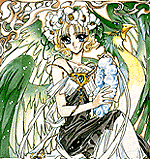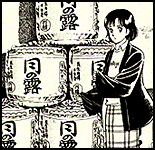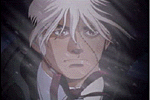           |
|
-->BACK Anime and manga are full of sex and violence: True or False? True: No escaping the fact that sexuality and violence exist
|

|
Hentai-manga (Perverted Comics) like these are banned in Singapore. They are perceived as pornography, and perhaps rightly so. Lots of sex and perversion, and sometimes more disturbing content like misogyny, rapes, bestiality etc. This genre is also predominant in anime, and in particular computer games (eg: Seek) |
|
Sadly, quite a number of anime are based around sex -- including stuff as distubring as rapes, bestiality, S&M etc. The fact that animation is a mainstream medium in Japan with adults constituting a substantial share of the market means that genres aimed specifically for that audience group exists. Such anime/manga (and PC games) are known as h-anime etc -- 'h' meaning 'hentai' or 'perverted' -- and can be considered as pornography. It's this genre -- something that's rarely seen (in such a scale, in particular) outside Japan -- that has won anime/manga the unwanted attention outside Japan, and which feel has contributed to their supposed notoriety.
The same would apply to the violence. Anime doesn't believe in self-censoring in this area, and sometimes, even encourages it when the situation calls for it. "When there's a fight, blood is inevitably spilled," anime master, Hayao Miyazaki once commented. "We can't avoid showing it." It's debatable how true this is. If a character's supposedly cruel and evil in a story, you'd expect him to reflect his nature in his actions; cutting down his enemies in a bloody melee is a more likely response than just throwing everyone into jail.
|

|
Genocyber ~ While briefly moving at times, esp in the relationship between the heroine and a homeless boy, this OVA series is still likely to have problems with the Censors here. Not for sex (none here) but jaw-dropping violence which is seemingly excessive. I know Genocyber has a cult following in the U.S., but if it's just over the violence and mutations, then it's hype anime fandom can do less with. |
|
In any case, the more harsh and brutal a story is, the more blood is likely to be spilit. This certainly detracts from cartoons in the west, where no one seems to get killed -- not even when there's supposed to be a major war going on (as in G.I.Joe). Admittedly, some anime do tend to overdo the violence.
|

|
Magical Knights Rayearth ~ Shoujo manga like this one by CLAMP are targeted at young girls. Themes heavy on western romanticism, fantasy or mystery for instance are common. So are tall, handsome young men, and of course, love...love...love ^_^. However, some of these titles do end up having a male following as well, with CLAMP's Rayearth, Tokyo Babylon, or Narumi Kakinochi's Vampire Princess Miyu being a few of them. Quite a few of these manga have been made into anime and vice versa. |
|
Shoujo Anime/Manga Bulk of the anime/manga created also caters to a shoujo market (young girls), and this genre is characterised more by romantic themes featuring doe-eyed heroines and handsome young men with long flowing hair. And even this market has its own sub-genres like detective stories, horror stories, romance stories etc. Surprisingly shoujo horror tends to be more disturbing than shonen (young boys) ones. Titles like Tokyo Babylon and X by Clamp, for example, have themes hinting at homosexuality or fraticide, and while the scenes aren't violent, they are nevertheless quite bloody. But as for sex and violence...Some of us might remember the Candy (Xiao Tian Tian) anime which captivated so many of us when it was on TV way back. That was shoujo anime (and manga, if you've got the comics) -- and sex or violence were certainly the last things the show was about.
|

|
Natsuko no Sake ~ Natsuko's Wine is a manga series about a woman from the city who's determined to fulfill her late-brother's dream of making the finest wine. A moving story about the human spirit and its place in the countryside, this series have been well-received among adult readers from even outside Japan. It's just one of the many manga titles that are written with adults in mind, and naturally deals with themes and emotions kids and even teenagers are unable to comprehend yet. |
|
Adult anime/manga Some anime/manga are also written specifically for adults. This doesn't mean they're pornographic, but rather, that they deal with themes only older audiences can relate to. Saimon Fumi's a well-known artist who's written a lot of manga for this market. Her stories like Tokyo Love Story(Dong Jing Ai Qing Gu Shi) and Asunaro Hakusho (Ai Qing Bai Pi Su) are all romances involving universtiy students on the threshold of entering society, while her 35 highlights some issues concerning adults around that age. Of course, the former two works were made into two Japanese TV drama series -- both of which many Singaporeans here had watched on TV without realising that they were actually based on manga.
So is anime/manga good or bad? The problem arises when only the negative genres get most of the coverage in the media, and those who are unfamiliar with anime/manga end up with a bad impression of both. Everytime I read such an article, I'd wonder how much anime/manga do these writers actually know besides all the stereotypes their fellow professionals have created.
|

|
With all forms of nudity in anime running the risk of being censored, even quality anime like Osamu Tezuka's Black Jack isn't spared. The tale about a black-market doctor -- which many consider is an uncompromising look at human tragedy -- was subjected to censoring because of nudity, and that literally destroyed the flow and mood of the whole OVA series. |
|
Double-standards Such biasness also get reflected in the authorities here. Jodie Foster (aka Nell) was permitted to appear nude (with a PG rating) on two occasions on the basis that it was a long-shot in one scene, and that the other wasn't provacative. However, the very slightest trace of nudity in anime gets the snip regardless of the context of the show. Kudos to the Board of Censors for letting some anime get in unedited despite the nudity (as in Macross Plus and Video Girl Ai), but I've also seen the same shows getting different treatment on different occasions (Macross Plus OVA was cut to bits, but the movie edition -- which contains the same 'offending' scenes, were left intact). Other quality anime which, sadly, suffered the same indignation include Osamu Tezuka's Black Jack, Rumiko Takahashi's Mermaid Forest, and even Ghost in the Shell (which surprisingly was uncensored when shown at the 9th Singapore Film Festival in 1996, and even rated 'G' in the programme. ~goes to show how much they know about anime ~) Nudity in manga that's published here also gets tampered -- nipples, for instance, get 'erased' off, or had clothing drawn (poorly) over them.
What then? This is one topic I'll try to elaborate on later on in this segment. There are so many genres covering so so many different themes that it's almost impossible to give readers a clearer view of what anime/manga actually has to offer -- not this such a brief FAQ. -->BACK |